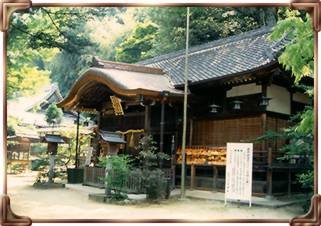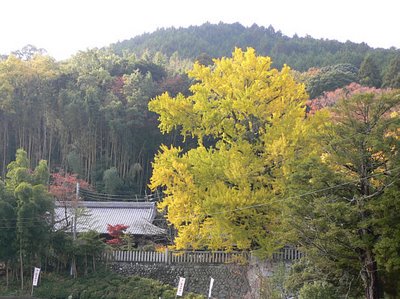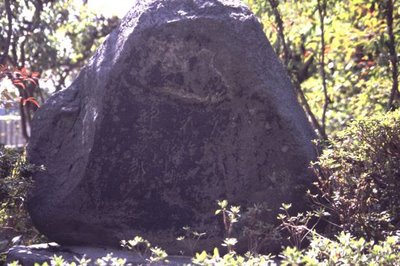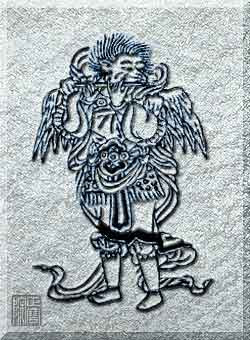:::::::::::::::::::::::::::::::::::::::::::::::::::::::::::::::::::::::::::::::::::::::::::::::::::::::::::::::::::::::::::
Ando Hiroshige, see below
Kuniyoshi, Utagawa ... 歌川国芳
Ichiyusai (一勇斎)
Utagawa Kuniyoshi (Japanese: 歌川国芳)
(1797 - April 14, 1861)
was one of the last great masters of the Japanese ukiyo-e style of woodblock prints and painting and belonged to the Utagawa school.
He was born in 1797, the son of a silk-dyer, originally named Yoshisaburō. Apparently he assisted his father's business as a pattern designer, and some have suggested that this experience influenced his rich use of color and textile patterns in prints. It is said that Kuniyoshi was impressed, at an early age of seven or eight, by ukiyo-e warrior prints, and by pictures of artisans and commoners (as depicted in craftsmen manuals), and it is possible these influenced his own later prints.
 His economic situation turned desperate at one point when he was forced to sell used tatami mats. A chance encounter with his prosperous fellow pupil Kunisada, to whom he felt (with some justice) that he was superior in artistic talent, led him to redouble his efforts (but did not create any lingering ill-feeling between the two, who later collaborated on a number of series). During the 1820s, Kuniyoshi produced a number of heroic triptychs that show the first signs of an individual style. In 1827 he received his first major commission for the series, One hundred and eight heroes of the popular Suikoden all told (Tūszoku Suikoden gōketsu hyakuhachinin no hitori), based on the incredibly popular Chinese tale, the Shuihu zhuan. In this series Kuniyoshi illustrated individual heroes on single-sheets, drawing tattoos on his heroes, a novelty which soon influenced Edo fashion. The Suikoden series became extremely popular in Edo, and the demand for Kuniyoshi’s warrior prints increased, gaining him entrance into the major ukiyō-e and literary circles.
His economic situation turned desperate at one point when he was forced to sell used tatami mats. A chance encounter with his prosperous fellow pupil Kunisada, to whom he felt (with some justice) that he was superior in artistic talent, led him to redouble his efforts (but did not create any lingering ill-feeling between the two, who later collaborated on a number of series). During the 1820s, Kuniyoshi produced a number of heroic triptychs that show the first signs of an individual style. In 1827 he received his first major commission for the series, One hundred and eight heroes of the popular Suikoden all told (Tūszoku Suikoden gōketsu hyakuhachinin no hitori), based on the incredibly popular Chinese tale, the Shuihu zhuan. In this series Kuniyoshi illustrated individual heroes on single-sheets, drawing tattoos on his heroes, a novelty which soon influenced Edo fashion. The Suikoden series became extremely popular in Edo, and the demand for Kuniyoshi’s warrior prints increased, gaining him entrance into the major ukiyō-e and literary circles.He continued to produce warrior prints, drawing much of his subjects from war tales such as Tale of the Heike (Heikei monogatari) and The rise and fall of the Minamoto and the Taira (Genpei seisuki). His warrior prints were unique in that they depicted legendary popular figures with an added stress on dreams, ghostly apparitions, omens, and superhuman feats. This subject matter is instilled in his works The ghost of Taira Tomomori at Daimotsu bay (Taira Tomomori borei no zu) and the 1839 triptych The Gōjō bridge (Gōjō no bashi no zu), where he manages to invoke an effective sense of action intensity in his depiction of the combat between Yoshitsune and Benkei. These new thematic styles satisfied the public’s interest in the ghastly, exciting, and bizarre that was growing during the time.
In the late 1840s, Kuniyoshi began again to illustrate actor prints, this time evading censorship (or simply evoking creativity) through childish, cartoon-like portraits of famous kabuki actors, the most notable being "Scribbling on the storehouse wall" (Nitakaragurakabe no mudagaki). Here he creatively used elementary, child-like script sloppily written in kana under the actor faces. Reflecting his love for felines, Kuniyoshi also began to use cats in the place of humans in kabuki and satirical prints. He is also known during this time to have experimented with ‘wide-screen’ composition, magnifying visual elements in the image for a dramatic, exaggerated effect (ex. Masakado’s daughter the princess Takiyasha, at the old Soma palace).
In 1856 Kuniyoshi suffered from palsy, which caused him much difficulty in moving his limbs. It is said that his works form this point onward were noticeably weaker in the use of line and overall vitality. Before his death in 1861, Kuniyoshi was able to witness the opening of the port city of Yokohama to foreigners, and in 1860 produced two works depicting Westerners in the city (Yokohama-e, ex. View of Honcho, Yokohama and The pleasure quarters, Yokohama).
He died at the age of 65 in March of 1861 in his home in Genyadana.
© More in the WIKIPEDIA !
LOOK at more
Woodblock prints by Kuniyoshi .
:::::::::::::::::::::::::::::::::::::::::::::::::::::::::::::::::::::::::::::::::::::::::::::::::::::
Samurai encountering Fudo Myo-o at a graveyard

source : commons.wikimedia.org
.............................................................................

Musha-e 'Soga no Hakoomaru' 曽我箱王丸
:::::::::::::::::::::::::::::::::::::::::::::::::::::::::::::::::::::::::::::::::::::::::::::::::::::

歌川国芳「那智の滝の文覚」 Mongaku under the waterfall of Nachi
- source : bluediary2.jugem.jp
:::::::::::::::::::::::::::::::::::::::::::::::::::::::::::::::::::::::::::::::::::::::::::::::::::::
. Tengupedia - 天狗ペディア - Tengu ABC-List .

An elephant catching a flying Tengu

. . . CLICK here for more Photos - Kuniyoshi Tengu ! !
Kyôga tengu no korishô - Tengu no hana Tengu and their noses"

CLICK for more of his Tengu paintings - 歌川国芳 天狗 !
:::::::::::::::::::::::::::::::::::::::::::::::::::::::::::::::::::::::::::::::::::::::::::::::::::::
Daruma

source : commons.wikimedia.org
:::::::::::::::::::::::::::::::::::::::::::::::::::::::::::::::::::::::::::::::::::::::::::::::::::
Daruma's Buffoonery (Dôke Daruma asobi)
Publisher: Horimasa 1847
After the imposition of a ban on actor prints in 1842, Kuniyoshi produced numerous humorous designs with thinly disguised actors’ portraits. In this series, well known actors are portrayed as Daruma, without any mention of their names. This series is listed as number 191 in Kuniyoshi by Basil William Robinson (Victoria and Albert Museum, London, 1961).
The prints in this series are each about 14 by 10 inches (36 by 25 centimeters), a size known as ôban.
Actors Nakamura Utaemon IV (right), Ichikawa Kuzô II (center) and Matsumoto Kôshirô VI (left) playing the game of ken
Actors Ichimura Uzaemon XII (right), Ichikawa Danjûrô VIII (center) and Onoe Kikujirô II (left)
Sumidagawa
Actors Bandô Shûka (right), Sawamura Sôjûrô V (center) and Onoe Kikugorô III (left)
Otowa no Taki
Actors Badnô Shûka and Onoe Kikugorô III
CLICK here to look at the prints :
source : www.kuniyoshiproject.com / William Pearl
「流行達磨あそび」
............... MORE :
Artistic Performances of Daruma-monks
(Tôsei Daruma no gei zukushi)
Description:
Five variations of Daruma: two squabbling women, two jugglers, and the actor Ichikawa Danjûrô VII as the aged Daruma, whose nose was so long that a thread, wound around his nose and one ear, would actually hold
Date: c. 1842
Toys with Actor's Expressions
(Sono omokage teasobi zukushi)
Description:
A lion's mask, a Daruma doll, a female doll with bare shoulders, an owl and a male doll playing with a piece of paper (fukigami)
Daruma Utsushi-E
Women and children enjoying shadow pictures
Date: c. 1832-1844
CLICK here to look at these prints :
source : www.kuniyoshiproject.com / William Pearl
:::::::::::::::::::::::::::::::::::::::::::::::::::::::::::::::::::::::::::::::::::::::::::::::::::::

Exhibition at Fuchu Art Museum
府中市美術館 : 歌川国芳
From 2010-03-20 to 2010-05-09
Kuniyoshi Utagawa is a late Edo period ukiyo-e artist whose fantastic motifs have received renewed critical attention in recent years. Full of a playful, ludic spirit, his works feature cats, warriors, huge monsters and fantastical creatures. A selection of these works were shown last spring in London, and later traveled to various European cities before ending up in New York this spring.
This exhibition features over 230 of Kuniyoshi's works over two parts.
source : www.tokyoartbeat.com
:::::::::::::::::::::::::::::::::::::::::::::::::::::::::::::::::::::::::::::::::::::::::::::::::::::
quote
The rootless woodblock prints of Kuniyoshi
By C.B. LIDDELL
There have been several exhibitions of the 19th-century ukiyo-e (woodblock print) artist Utagawa Kuniyoshi in recent years. In 2009, there was "Woodblock Prints of Eccentricity and Laughter" at the Fuchu Art Museum and last year we had "Utagawa Kuniyoshi: Unparalleled Ukiyo-e Artist" at the Ota Memorial Museum. Both shows were quite comprehensive and treated Kuniyoshi with all the respect accorded a major artist — as he is now considered to be.
This year, we have the grandly titled "Kuniyoshi: Spectacular Ukiyo-e Imagination." With 420 works, it claims to be the biggest exhibition of the artist's works yet, and seems designed to elevate him to a level equal to the likes of Katsushika Hokusai.

But, while the show is ostensibly impressive and awe-inspiring, it does little to develop our understanding of the artist, falling back on the uninspiring narrative of a polymorphously creative individual in overdrive.
The breathless buzzwords in the title give it away. These are echoed by the exhibition's publicity, presentation, and catalogue, which show a tendency to gush over its subject in prose that reveals hard-sell intent more than curatorial insight.
"Variety was Kuniyoshi's watchword in technique as well as subject matter," exclaims a typically overloaded phrase in the catalogue's English essay. This is closely followed by the information that Kuniyoshi "explored developing compositions from a multiplicity of perspectives," conjuring up a picture of the artist sketching while standing on his head, and the assurance that his "wide screen compositions" are "particularly spectacular."
The vision of the artist that the curators are presenting is of some irrepressible fount of pure creativity who just happened to burst forth in the Edo Period (1603-1867) and who must be worshipped without question.
Of course, they might very well be onto something. As you pass through the exhibition, you are bombarded with what seems like an endless stream of unexpected and innovative imagery.
Pictures of warriors fighting battles and monsters, give way to epic scenes with giant ghosts and whale hunts, which in turn lead to depictions of holy men and paragons of virtue. Kimono-clad beauties delight our eyes, then give way to landscapes and pictures of anthropomorphized animals and objects, followed by trick pictures using ambiguous silhouettes and tiny human figures arranged to create the image of larger faces. A one-trick pony, Kuniyoshi certainly wasn't!
After this colorful carousel, the point of least resistance is to just surrender to the idea offered, of Kuniyoshi as the incarnation of pure "boundless imagination."
The problem with this, however, is that it is ultimately an unsatisfying narrative as it merely places the artist behind a curtain of blind adoration that ignores his failings as an artist — some of his pictures are hopelessly cluttered and compositionally weak — as well as the elements that tie him to his era.
source : Japan Times, Feb. 2, 2012
"Kuniyoshi: Spectacular Ukiyo-e Imagination"
Mori Arts Center Gallery
:::::::::::::::::::::::::::::::::::::::::::::::::::::::::::::::::::::::::::::::::::::::::::::::::::::
More by Kuniyoshi
Badger Tanuki and his big scrotum .. with Daruma
Daruma and Tokusakari ... two-way pictures, 上下絵 (じょうげえ jooge-e)
The Monster Cats enjoying a Dance
Priest Nichiren in the Snow on Sado Island
.................................................................................
Daruma eating buckwheat noodles
流行達磨遊び-蕎麦・首引き


流行達磨遊び-手が出る足が出る
Daruma, Life Beeing Breathed into a Papier-mache Doll
Shared by Ken Ishihashi - Facebook
. だるま夜話 Daruma Yobanashi - Dancing
Daruma Story for a Spooky Night .
. 歌川国芳 達磨 Kuniyoshi and Daruma .
Ichiyusai Kuniyoshi 一勇斎 国芳
giga 戯画 playful pictures
:::::::::::::::::::::::::::::::::::::::::::::::::::::::::::::::::::::::::::::::::::::::::::::::::::::
:::::::::::::::::::::::::::::::::::::::::::::::::::::::::::::::::::::::::::::::::::::::::::::::::::::
二代歌川広重(歌川重宣)Utagawa Shigenobu
Shigenobu Utagawa, Hiroshige II
(1826 - 1869)
Utagawa Shigenobu (1826-1869) was the chief pupil of the the second great master of the Japanese landscape woodblock print, Hiroshige. He took over his master's go 'Hiroshige' on the latter's death, and is now principally known by it, being more usually referred to as 'Hiroshige II'.
He was born into a family of fire-watchmen, like his master Hiroshige I. He was originally named Suzuki Chimpei, and as his artistic career began, he was given the name Shigenobu (重宣) by his master Hiroshige I. He was made part of his master's household, and married Hiroshige I's daughter Tatsu.
MORE
source : mercury.lcs.mit.edu J. Noel Chiappa

source : www.jti.co.jp
新板手遊尽し Teasobi Tsukushi
Things to play with, including a Daruma だるま
When these prints became more popular, Daruma was one of the common features in them.
:::::::::::::::::::::::::::::::::::::::::::::::::::::::::::::::::::::::::::::::::::::::::::::::::::::
Utagawa Hiroshige 歌川広重
Ando Hiroshige 安藤広重
(1797-1858)

:::::::::::::::::::::::::::::::::::::::::::::::::::::::::::::::::::::::::::::::::::::::::::::::::::::
kigo for late autumn
Hiroshige Ki 広重忌 Hiroshige Memorial Day
1797 in Edo – October 12, 1858
. Memorial Days of Famous Poeple .
:::::::::::::::::::::::::::::::::::::::::::::::::::::::::::::::::::::::::::::::::::::::::::::::::::::
"Fifty-Three Stations of the Tokaido"
"Famous Places of Edo: A Hundred Views"
Utagawa Hiroshige (sometimes called Ando Hiroshige)
was the second of the two great masters of the Japanese landscape woodblock print, after Hokusai. He is particularly known for his scenes featuring snow and rain, which feauture in many of his best and most famous images, and which has led to his becoming know as "the artist of rain, snow and mist".
He was born (with the name Ando Tokutaro) in Edo (the name of Tokyo at that point in time), and originally was intended to follow the career of his father, a fire-watchman. After his parents' death in 1809, the orphan Hiroshige gravitated toward the art world, an inclination which had been encouraged by his father.
source : mercury.lcs.mit.edu
quote
"A Road Traveled by Feudal Lords and Pet Dogs:
Hiroshige's Fifty-three Stations of the Tokaido,
Primarily from the Hoeido and Reisho Editions"
SUNTORY MUSEUM OF ART

Yokkaichi-Juku 四日市宿
A popular subject of literature and art during the Edo Period (1603-1867) was the journey along the Tokaido highway between Edo (present-day Tokyo) and Kyoto, the most famous depictions of which come from ukiyo-e (woodblock print) artist Utagawa Hiroshige (1797-1858). Hiroshige produced more than 20 editions of these works, one of which is known as the Hoeido — 55 oban (26.5×39 cm) full-color prints depicting all 53 stations along the highway.
source : www.japantimes.co.jp
The international Hiroshige research website:
Theo de Kreijger
source : www.utagawahiroshige.nl
. Mentioning Hiroshige in the Daruma Museum .
:::::::::::::::::::::::::::::::::::::::::::::::::::::::::::::::::::::::::::::::::::::::::::::::::::::
Utagawa Toyokuni 'Toyokuni I'
Look at more than 5000 of his prints!
source : ukiyo-e.org
:::::::::::::::::::::::::::::::::::::::::::::::::::::::::::::::::::::::::::::::::::::::::::::::::::::::::::::::::::::::::::
Utagawa Yoshikazu 歌川芳員
(active about 1848-1863)

UCSF Japanese Woodblock Print Collection - Fudō myōō
. Fudō Myō-ō, Fudoo Myoo-Oo 不動明王 Fudo Myo-O
Acala Vidyârâja - Vidyaraja .
:::::::::::::::::::::::::::::::::::::::::::::::::::::::::::::::::::::::::::::::::::::::::::::::::::::::::::::::::::::::::::
[ . BACK to WORLDKIGO . TOP . ]
[ . BACK to DARUMA MUSEUM TOP . ]
- #kuniyoshi #utagawa -
:::::::::::::::::::::::::::::::::::::::::::::::::::::::::::::::::::::::::::::::::::::::::::::::::::::::::::::::::::::::::::









































